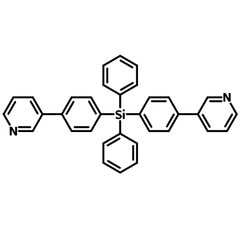DPPS
CAS Number 1152162-74-7
Electron / Hole Transport Layer Materials, High Purity Sublimed Materials, Semiconducting Molecules, TADF Materials
DPPS, ETL and HBL material for photo-electronic devices
High-purity (>99.0%) and available online for priority dispatch
Diphenyl-bis[4-(pyridin-3-yl)phenyl]silane, DPPS, has two pyridyl groups attached to the tetra-phyenylsilane. Hence, it is electron-deficient.
Almost considered as an insulator, DPPS is a weak electron-transporting material with a wide bandgap Eg = 4.0 eV. Due to its deep HOMO energy level, DPPS is also used as a hole-blocking layer material in photo-electronic devices.
General Information
| CAS number | 1152162-74-7 |
|---|---|
| Full name | Diphenyl-bis(4-(pyridin-3-yl)phenyl)silane |
| Chemical formula | C34H26N2Si |
| Molecular weight | 490.67 g/mol |
| Absorption | λmax 251 nm in DCM |
| Fluorescence | λem 366 nm in DCM |
| HOMO/LUMO | HOMO = 6.5 eV, LUMO = 2.5 (ET = 2.7 eV) |
| Synonyms | 3,3'-[(Diphenylsilylene)di-4,1-phenylene]bispyridine |
| Classification / Family | Organic electronics, Hole-blocking layer materials (HBL), Electron-transporting layer materials (ETL), TADF-OLEDs, Sublimed materials. |
Product Details
| Purity | Sublimed >99.0% (HPLC) |
|---|---|
| Melting point | TGA: >250 °C (0.5% weight loss) |
| Colour | White powder/crystals |
*Sublimation is a technique used to obtain ultra pure-grade chemicals. For more details about sublimation, please refer to the Sublimed Materials.
Chemical Structure

Device Structure(s)
| Device structure | ITO/TPDPES:TBPAH (20 nm)/BTPD (20 nm)/BCBP:15%FIrpic (30 nm)/DPPS (30 nm)/LiF (0.5 nm)/Al (100 nm) [1] |
|---|---|
| Colour | Blue |
| Max. Luminance | 10,578 cd/m2 |
| Max. Current Efficiency | 50.5 cd/A |
| Max. EQE | 22.0% |
| Max. Power Efficiency | 47.0 lm W-1 |
| Device structure | ITO/HATCN (10 nm)/NPD (40 nm)/TAPC (10 nm)/4% Pt1O2me2:26mCPy (25 nm)/DPPS (10 nm)/BmPyPB(40 nm)/LiF/Al [2] |
|---|---|
| Colour | White |
| Max. Current Efficiency | 80.3 cd/A |
| Max. EQE | 26.7% |
| Max. Power Efficiency | 68.3 lm W-1 |
| Device structure | ITO/PEDOT:PSS (70 nm)/TAPC (15 nm)/mCP (5 nm)/mCPCN:DMAC-TRZ 8 wt% (20 nm)/DPPS (5 nm)/ 3TPYMB (45 nm)/LiF (0.5 nm)/Al (150 nm) [3] |
|---|---|
| Colour | Green |
| Max Current Efficiency | 71.2 cd/A |
| Max EQE | 21.8% |
| Max. Power Efficiency | 60.9 lm W-1 |
| Device structure | ITO/HATCN (10 nm)/NPD (40 nm)/TAPC (10 nm)/6% PtON1*: 26mCPy (20 nm)/6% PtOO8: 26mCPy (2 nm)/2% PtN3N-ptb:26mCPy (3 nm)/DPPS (10 nm)/BmPyPB (40 nm)/LiF (1 nm)/Al (100 nm) [4] |
|---|---|
| Colour | White |
| Current Efficiency@100 cd/m2 | 40 cd/A |
| EQE@100 cd/m2 | 18.4% |
| Power Efficiency@100 cd/m2 | 25 lm W-1 |
| Device structure | ITO/TAPC (45 nm)/mCP (10 nm)/BImBP*:12% FIrpic (35 nm)/DPPS (55 nm)/LiF (0.9 nm)/Al (120 nm) [5] |
|---|---|
| Colour | Blue |
| Max. Luminance | 9,513 cd/m2 |
| Max. Current Efficiency | 25.7 cd/A |
| Max. EQE | 22.0% |
| Max. Power Efficiency | 50.4 lm W-1 |
*For chemical structure information, please refer to the cited references.
Pricing
| Grade | Order Code | Quantity | Price |
|---|---|---|---|
| Sublimed (>99.0% purity) | M2130A1 | 250 mg | £310 |
| Sublimed (>99.0% purity) | M2130A1 | 500 mg | £500 |
| Sublimed (>99.0% purity) | M2130A1 | 1 g | £850 |
MSDS Documentation
Literature and Reviews
- Nearly 100% Internal Quantum Efficiency in an Organic Blue-Light Electrophosphorescent Device Using a Weak Electron Transporting Material with a Wide Energy Gap, L Xiao et al., Adv. Mater., 21, 1271–1274 (2009); DOI: 10.1002/adma.200802034.
- Tetradentate Platinum Complexes for Effi cient and Stable Excimer-Based White OLEDs, T. Fleetham et al., Adv. Funct. Mater., 24, 6066–6073 (2014); DOI: 10.1002/adfm.201401244.
- A versatile thermally activated delayed fluorescence emitter for both highly efficient doped and non-doped organic light emitting devices, W-L. Tsai et al., Chem. Commun., 51, 13662 (2015); DOI: 10.1039/c5cc05022g.

 DPPS MSDS sheet
DPPS MSDS sheet